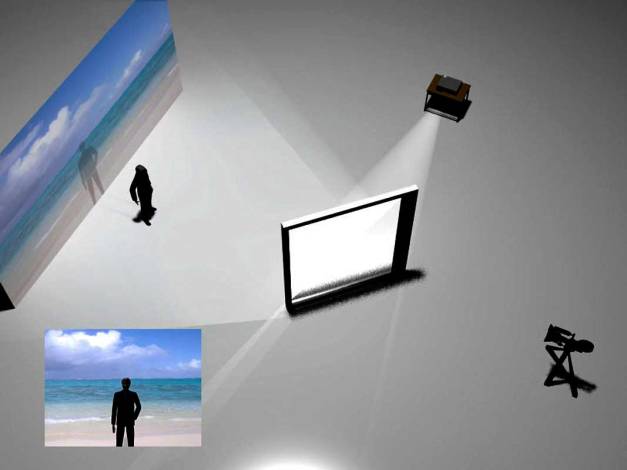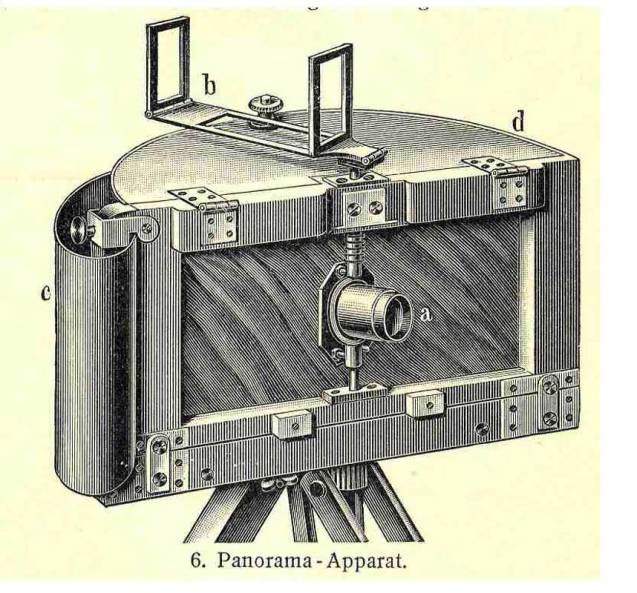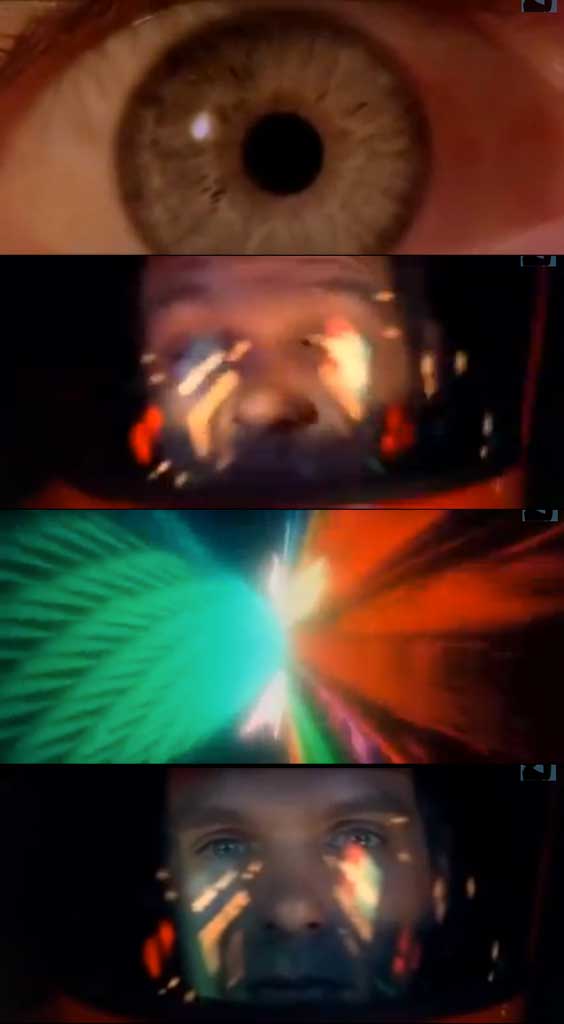Modern special effects – certainly in my experience – really date from 1968 – the year that Stanley Kubrick’s 2001 A Space Odyssey was released. Of course, 2001 was made without any computer-generated imagery, but the aesthetics, the ‘visualisation of a near future that hadn’t quite got off the drawing board yet’ makes Kubrick one of those interesting artists who explored analogue prototypes of the digital (CGI) future that would be glimpsed a decade or so later – in the late 1970s (see previous post). Kubrick employed a 23 year old animator called Doug Trumbull to create some of the special effects he needed for 2001. Interestingly, Trumbull’s parents had been a mechanical engineer and an artist – a perfect gene-pool for a special-effects artist!
Previously Trumbull had been making detailed animations about space travel, for the company Graphic Films in LA, and when Kubrick approached his colleague Con Pederson about the sfx on 2001, Trumbull also pitched for the job (eventually both Pederson and Trumbull were employed by Kubrick,, along with Tom Howard and Wally Reevers).
in the 1960s special effects were still largely to do with model-making and clever cinematography, and what was clever about 2001 was two things: the way the camera was controlled mechanically, so that Kubrick could shoot the high-resolution sequences marrying together live-action foregrounds with front-projected very high resolution backgrounds; and secondly, the new ‘Slit-Scan’ process invented by Trumbull for the Star-Gate sequence in the film.
Trumbull lists all the important innovations and workflow practices for 2001:
• the creation of a control room/riling system/idea centre – a room where all the ideas, storyboards, visuals, status reports, etc were kept and filed.
“One of the most serious problems that plagued us throughout the production was simply keeping track of all ideas, shots, and changes and constantly re-evaluating and updating designs, storyboards, and the script itself. To handle all of this information, a “control room,” constantly manned by several people and with walls covered by pert charts, flow diagrams, progress reports, jog sheets, punch cards, and every conceivable kind of filing system, was used to keep track of all progress on the film.”
Trumbull: Creating Special Effects for 2001 A Space Odyssey (American Cinematographer 49(6):416-420,451-453. June 1968.)
For a flavour of this data-base room, see:
http://www.mach25media.com/2001lacma.html
• the use of front projection and retroreflective matting instead of glass-matte paintings to create more realistic backgrounds (since the 1990s this has been superseded by blue-screen/green-screen systems.
http://www.visual-memory.co.uk/sk/2001a/page2.html
Herb A. Lightman : Front Projection for “2001: A Space Odyssey” American Cinematographer

Front-Projection special effects set-up. Instead of a glass painting, Kubrick adapted a front projection technique to create high-resolution back-drops for his Ape-Man sequences and other sequences used throughout 2001 A Space Odyssey. The rear screen is made of a highly reflective material made by 3M – its called a retro-reflective screen. The backgrounds were shot on 10×8 Ektachrome transparencies, and Kubrick had to construct his own 10×8 size projector. These background images were projected onto a semi-reflective glass screen, so that in one take the camera could record both foreground and background images in one take.
”
On the set of “2001: A Space Odyssey,” producer-director Stanley Kubrick uses binoculars to check fine focus on the vast front-projection screen. Special 3M material reflects 100 times the light falling upon the screen, provided that projector and film camera lenses are aligned on precisely the same axis. Kubrick wanted to use an 8×10 transparency for maximum sharpness, found there was no projector for it in existence, built his own.”
• Back Projection (rear-screen or back-projection was used in 2001 for shots of instrument panels)

“Interior view of the Orion commuter ship approaching the Space Station, with all of its scopes showing readouts. Preparation of these readouts for all the spacecraft ate up tons of technical material and required many months to animate.” Each instrument screen on the cockpit dashboard was a back-projected animation. Here the interface graphics (the cockpit screen readouts) were animated diagrams and schematics from hundreds of technical journals, coloured with gel filters.
• Rotoscoping – where other cheaper or easier effects could not be used, Trumbull, Pederson and co used manually intensive rotoscoping’:

Max Fleischer – the animator later responsible for Betty Boop, Talkartoons and Popeye among many other cartoons – invented this rotoscoping rig in 1917. The idea of tracing live action as an animation tool led to the inricate special effects and compositing technologies in use today. Fleischer also developed ‘karaoke’-style on-screen bouncing-ball lyrics in the 1920s. Rotoscoping involved back projecting a live-action sequence frame by frame onto a translucent drawing frame, where the main actions the animator was interested in could be traced off onto a transparent animation cel.
“Since we couldn’t afford to tie up the animation stand, or any camera, for very laborious and time-consuming rotascope jobs on so many shots, a unique rotascoping system was devised. Using ordinary darkroom enlargers, equipped with carriers for rolls of 70mm film, each frame-by-frame image was projected onto specially marked animation peg boards, to which the projected image of the perforations had to be visually aligned.” (Trumbull, op cit)
• The best technical advisors/the cooperation of leading research/R&D labs on the promise of product placement:
“On the recommendation of Clarke, Kubrick hired spacecraft consultants Frederick Ordway and Harry Lange, who had assisted some of the major contractors in the aerospace industry and NASA with developing advanced space vehicle concepts, as technical advisors on the film. Ordway was able to convince dozens of aerospace giants such as IBM, Honeywell, Boeing, General Dynamics, Grumman, Bell Telephone, and General Electric that participating in the production of “2001” would generate good publicity for them. Many companies provided copious amounts of documentation and hardware prototypes free of charge in return for “product placements” in the completed film. They believed that the film would serve as a big-screen advertisement for space technology and were more than willing to help out Kubrick’s crew in any way possible. Lange was responsible for designing much of the hardware seen in the film.”
George D. DeMet : The Special Effects of “2001: A Space Odyssey”
Originallly published in DFX, July 1999
• Doug Trumbull: more on Slit Scan
Slit-scan was a technique of gradually exposing film, one strip at a time while the camera and/or the background was moved in stages. Trumbull adopted the idea from panoramic camera, and from the idea of the ‘photo-finish’ cameras invented to determine which horse had actually won a race.

output from a modern ‘photo-finish’ camera system. The camera records a temporal event, just as the panoramic camera recorded a spatial event.

Joseph Puchberge: Panoramic ‘strip-scan’ camera invented in 1843, for the purpose of taking wide aspect ratio panoramas.
Slit-Scan – the progressive, labour intensive, special effects process now wholly superseded by digital effects.
I’d like to compare Trumbull’s final ‘Star-Gate’ sequence from 2001 A Space Odyssey with a recently made video explaining the slit-scan process.
Trumbull: Stargate Sequence from 2001 A Space Odyssey (1968)
“As the black monolith vanishes into a strangely symmetrical alignment of Jupiter and its moons, the camera pans up and the “Stargate” engulfs the screen. For this infinite corridor of lights, shapes, and enormous speed and scale, I designed what I called the Slit-Scan machine. Using a technique of image scanning as used in scientific and industrial photography, this device could produce two seemingly infinite planes of exposure while holding depth-of-field from a distance of fifteen feet to one and one-half inches from the lens at an aperture of F/1.8 with exposures of approximately one minute per frame using a standard 65mm Mitchell camera.” (Trumbull: op cit)
Slit-scan recreated: John Hess explains slit-scan and recreates a slit-scan rig:
https://www.youtube.com/watch?v=KhRo2WbWnKU

Bernard Lodge: original Dr Who titles 1963. Working from a technical innovation called Howl-Around discovered and used by BBC video technician Ben Palmer, Bernard Lodge began his own experiments with video feedback (howl-around), much as Delia Derbyshire and Dick Mills had utilised audio-feedback in their production of Ron Grainer’s Dr Who theme. This produced visuals that are the video equivalent of Trumbull’s slit-scan effects 5 years later – a mysterious, electronic, temporal-spatial voyage through the new space time of cybernetic (video-feedback) space.
Slit-scan used in original Dr Who titles, designed by Bernard Lodge (1963)

One thought on “Doug Trumbull: Special Effects on 2001 A Space Odyssey”